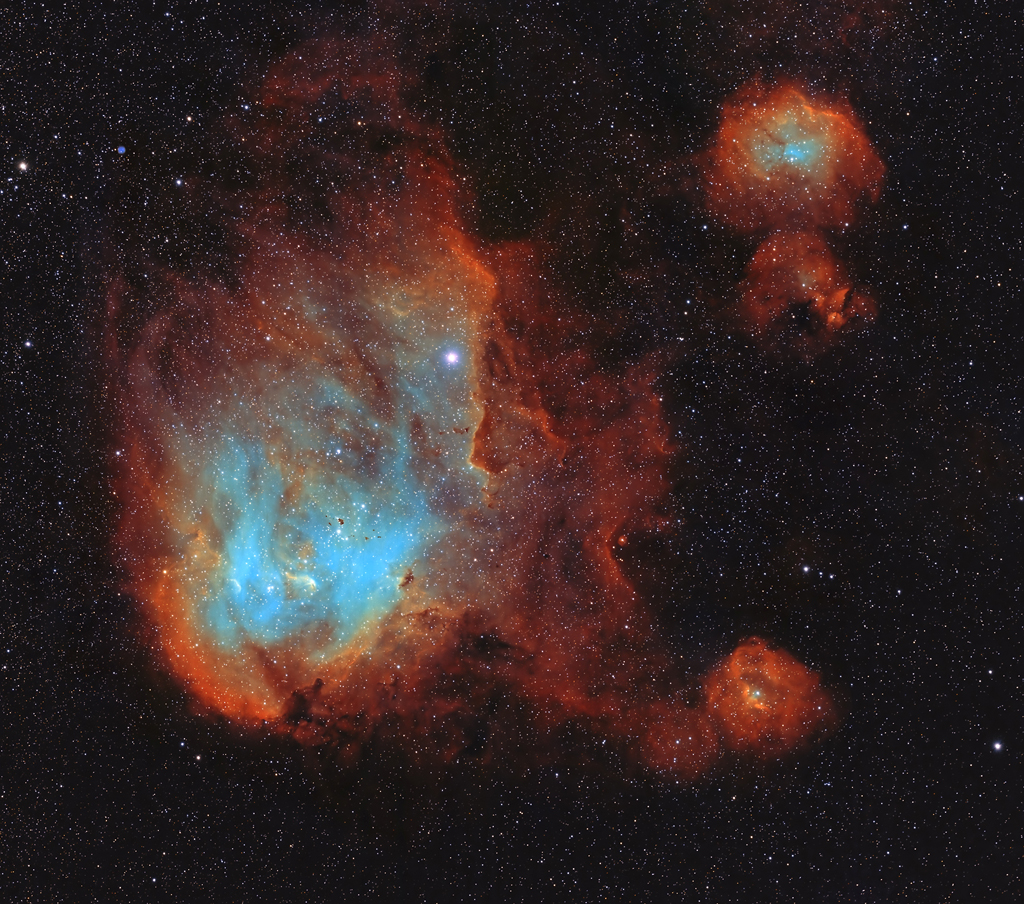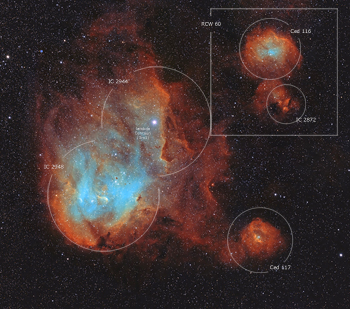 |
CHAMÄLEON + ONJALA OBSERVATORY DeepSky | SITEMAP HOME CHAMÄLEON |
|
 |
|||
| « zurück zur Startseite
galaktische Nebel « back to home galactic nebula |
Großes Bild laden - load large image 2100
x 1900 Pixel Aufnahmedaten Image data |
IC 2944 - Emission Nebula in the Constellation Centauris - a Narrow Band Mosaic of 2

Der Emissionsnebel IC 2944 ist ein prächtiges Motiv des südlichen Himmels. IC 2944 trägt auch die Bezeichnung Gum 42, die Nummer aus dem Katalog der südlichen H-II Regionen von Colin Gum. Seine Entfernung zum Sonnensystem beträgt etwa 6500 Lichtjahre. Der helle Stern lambda Centauri trägt nicht zur Ionisation des Nebels bei, er steht nur direkt in der Sichtlinie zur Nebelregion, die Entfernung zum Sonnensystem beträgt nur 430 Lichtjahre. Im englischen Sprachraum hat der Nebelkomplex den Beinamen "running chicken", wobei es schwer fällt in der Nebelform ein "rennendes Hühnchen" zu sehen. Der Lambda Centauri Nebel wurde am 5. Mai 1904 von Royal Harwood Frost entdeckt.
Das große Sternentstehungsgebiet ist eine bemerkenswerte H-II Region. Im Inneren des Nebels stehen mindestens 9 extrem heiße, blaue Sterne des Spektraltyps O mit Helligkeiten von der 6,5 bis zur 9 Größenklasse. Der hellste dieser Sterne ist HD 101205, ein Doppelstern, vielleicht sogar ein Mehrfachsystem. Dazu kommen noch viele weitere Sterne des Spektraltyps B, die dazu beitragen das Wasserstoffgas zu ionisieren. Die Strahlung dieser vielen blauen Sterne erzeugen Reflexionsnebel die die rote H-alpha Emission überlagert. Alle internen Sterne in IC 2944 gehören zu dem offenen Sternhaufen IC 2948.
Im Kernbereich des Nebelkomplexes befinden sich einige dunkle Bok Globulen, in diesem Fall nach ihrem Entdecker hier Tackerey Globulen genannt, in denen neue Sterne entstehen.
Object description
The emission nebula IC 2944 is a magnificent motif of the southern sky. IC 2944 also bears the designation Gum 42, the number from Colin Gum's catalogue of southern H-II regions. Its distance from the solar system is about 6500 light years. The bright star lambda Centauri does not contribute to the ionisation of the nebula, it is only directly in the line of sight to the nebular region, its distance to the solar system is only 430 light years. In the English-speaking world, the nebula complex has the nickname "running chicken", although it is difficult to see a "running chicken" in the nebula shape. The Lambda Centauri Nebula was discovered on 5 May 1904 by Royal Harwood Frost.
 |
The large star-forming region is
a remarkable H-II region. Inside the nebula are at least 9 extremely hot, blue
stars of spectral type O with magnitudes ranging from 6.5 to 9 magnitudes. The
brightest of these stars is HD 101205, a double star, perhaps even a multiple
system. In addition, there are many other stars of spectral type B, which help
to ionise the hydrogen gas. The radiation from these many blue stars creates
reflection nebulae that overlap the red H-alpha emission. All internal stars in
IC 2944 belong to the open star cluster IC
2948. In the core region of the nebula complex are some dark Bok globules, in this case called Tackerey globules after their discoverer here, in which new stars are formed. Eine RGB Version der Region zeigen wir hier. Ein hochaufgelöste Version der Bok Globulen in NGC IC 2948 hier und eine hochaufgelöste schmalband Aufnahme von NGC 2944 hier. An RGB version of the region is shown here. A high resolution version of the Bok globules in NGC IC 2948 here and a high resolution narrow band image of NGC 2944 here. « Hier oder auf das Vorschaubild zum Laden eines großen Bildes mit Objektbezeichnungen klicken. « Click here or on the thumbnail to load a large image with object annotations. |
IC 2944 - Emission Nebula in the Constellation Centauris - a Narrow Band Mosaic of 2
Image data
26.+27.05.2022 - mosaic of 2 - H-alpha: 62 x 300s, SII: 60 x 300s and OIII: 62 x 300s, ZWO ASI 294 MM
Telescope: 105mm SDP Pentax with Reducer at f = 500mm
Location: Chamäleon Observatory, Onjala Lodge, Namibia
Image acquisition and processing: DeepSkyStacker, Pixinsight and Photoshop by Bernd Gooßmann
 |
 |
 |
 |
 |
 |
 |
| Sonne | Mond | Sonnensystem | DeepSky | Weitwinkel | Verschiedenes | Spez. Projekte |